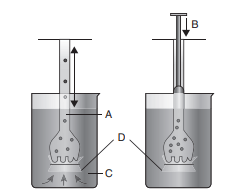1. How we can get the egg membrane?
a) Remove yolk and albumin through a small hole at one end of the egg
b) Place the shell in dilute HCl for few hours
c) Both (a) and (b)
d) None of these
Explanation: Both (a) and (b)
2. Identify A to D in the given figure. 
a) A–Pressure, B–Membrane, C–Water, D–Sucrose solution
b) A–Sucrose solution, B–Pressure, C–Water, D–Membrane
c) A–Membrane, B–Sucrose solution, C–Pressure, D–Water
d) A–Sucrose solution, B–Membrane, C–Water, D–Pressure
Explanation: A–Sucrose solution, B–Pressure, C–Water, D–Membrane
3. Select the correct statement from the following:
a) Osmotic pressure is the negative pressure applied.
b) Osmotic potential is positive.
c) More is the solute concentration of solution, more will be the pressure required to prevent
water from diffusing in.
d) The net direction and the rate of osmosis does not depend on the pressure gradient nor on
concentration gradient.
Explanation: More is the solute concentration of solution, more will be the pressure required to prevent water from diffusing in.
4. Which portion of the root absorbs both water and minerals?
a) Terminal portion of roots
b) Zone of cell elongation
c) Zone of cell formation
d) Zone of cell differentiation
Explanation: Zone of cell differentiation
5. Meaningful girdling (ringing) experiments cannot be done on sugarcane because
a) Phloem is present inside the xylem
b) It cannot tolerate the injury
c) Vascular bundles are scattered
d) Plants are very delicate
Explanation: Meaningful girdling (ringing) experiments cannot be done on sugarcane because vascular bundles are scattered
6. Some leaves are removed from the stem cuttings planted for vegetative propagation. This is
done
a) To increase water uptake
b) Because it helps in rooting of cuttings
c) To reduce water loss
d) Because the cuttings need less food
Explanation: To reduce water loss
7. In terms of permeability, the cell wall and plasmalemma are
a) Permeable and differentially permeable respectively
b) Both semi-permeable
c) Semi-permeable and differentially permeable
d) Both differentially permeable
Explanation: Permeable and differentially permeable respectively
8. The process of osmosis involves
a) Movement of solute through semi-permeable membrane
b) Movement of solvent through a semi-permeable membrane
c) Movement of solution through a semi-permeable membrane
d) None of these
Explanation: The process of osmosis involves movement of solvent through a semi-permeable membrane
9. Dry seeds when placed in water swells due to
a) Imbibitions
b) Absorption
c) Diffusion
d) Adsorption
Explanation: Imbibitions
10. A cell placed in strong solution will shrink because
a) Cytoplasm will decompose
b) Mineral salt will break the cell wall
c) Salt water enter the cell
d) Water comes out by exosmosis
Explanation: A cell placed in strong solution will shrink because water comes out by exosmosis